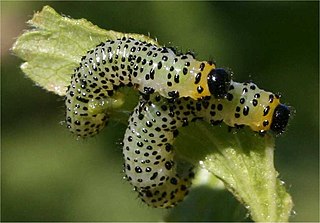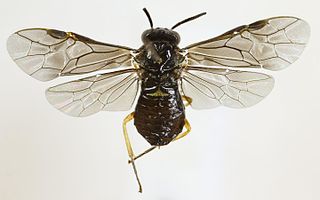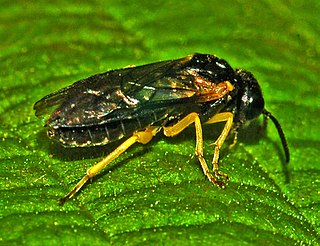
Sawflies are wasp-like insects that are in the suborder Symphyta within the order Hymenoptera, alongside ants, bees, and wasps. The common name comes from the saw-like appearance of the ovipositor, which the females use to cut into the plants where they lay their eggs. The name is associated especially with the Tenthredinoidea, by far the largest superfamily in the suborder, with about 7,000 known species; in the entire suborder, there are 8,000 described species in more than 800 genera. Symphyta is paraphyletic, consisting of several basal groups within the order Hymenoptera, each one rooted inside the previous group, ending with the Apocrita which are not sawflies.

The Tenthredinoidea are the dominant superfamily of sawflies within the Symphyta, containing some 8,400 species worldwide, primarily in the family Tenthredinidae. All known larvae are phytophagous, and a number are considered pests.

The Pergidae are a moderate-sized family of sawflies occurring in the Western Hemisphere and the Australasian Region. The Pergidae are, with almost 450 described species, the third-largest family of Symphyta after the Tenthredinidae and the Argidae. Morphologically, most pergids are typically sawfly-like, but the form of the antennae varies considerably in number of segments and from simple to serrate and pectinate or even bipectinate. Sexual dimorphism is common and reflected in differences in type of antennae, colour, and size. Included are some of the few known apterous sawflies, those of the genus Cladomacra occurring in Papua New Guinea and Indonesia, and a species with brachypterous females, Clarissa tasbates, in Tasmania.

Tenthredinidae is the largest family of sawflies, with well over 7,500 species worldwide, divided into 430 genera. Larvae are herbivores and typically feed on the foliage of trees and shrubs, with occasional exceptions that are leaf miners, stem borers, or gall makers. The larvae of externally feeding species resemble small caterpillars. As with all hymenopterans, common sawflies undergo complete metamorphosis.

Nematus ribesii is a species of sawfly in the family Tenthredinidae. English names include common gooseberry sawfly and imported currantworm. This insect is best known as a pest of gooseberries. The larvae feed on the foliage of the plant, often defoliating it completely.

The pear slug or cherry slug is the larva of the sawfly, Caliroa cerasi, a nearly worldwide pest. The species was first described by Carl Linnaeus in his landmark 1758 10th edition of Systema Naturae. They are not slugs but are a kind of sawfly of the family Tenthredinidae. The pear slug is an important pest that eats leaves of cherry, pear, and plum trees, leaving behind a skeleton of veins. The larvae cover themselves in green slime, making themselves unpalatable to predators. The larva molt between five and eight times before being fully grown. When the larvae are fully grown, they drop from the tree to the ground and pupate underground. The adult sawfly emerges from the pupal case and climbs from the soil to mate and lays eggs on the leaves of the host plant, completing the life cycle.

Nematinae is a subfamily of sawflies belonging to the family Tenthredinidae. It contains over 1250 described species in ~40 genera. Members of this subfamily feed on a wide range of plants and employ a wide range of feeding habits, both internally and externally, on their host plants.

Allantinae is a subfamily of sawflies in the family Tenthredinidae, and the largest subfamily of that family, with about 110 genera. The subfamily is considered to consist of five to six tribes, and are medium to large sawflies.

Tenthredo scrophulariae, the figwort sawfly, is a species of the family Tenthredinidae, subfamily Tenthredininae.

The genus Caliroa is a group of sawflies in the family Tenthredinidae. The larvae are slimy in appearance, and are sometimes referred to as "slugs" although they are insects rather than gastropods.

Tenthredininae are a subfamily of sawflies within the family Tenthredinidae, the largest sawfly family. It consists of about 50 genera, including the type genus Tenthredo. It also includes most of the larger and more colourful members of the family. Some authorities divide these into tribes. Distribution is Northern Hemisphere and holarctic.
Lathrolestes ensator is a species of wasp in the family Ichneumonidae. it is a parasitoid of the apple sawfly Hoplocampa testudinea. Both insects are native to Europe, but the sawfly has been accidentally introduced into North America where it has become established. The larvae of the sawfly tunnel into developing apple fruitlets which later fall to the ground, where the larvae continue their development. The wasp parasitises the larvae and has been released in North America as part of a biological control programme for the sawfly.

Nesoselandria morio is a species of sawflies belonging to the family Tenthredinidae subfamily Tenthrediniinae. It is the only species of the genus Nesoselandria.

Aneugmenus padi is a species of sawfly.

Eriocampa ovata, known generally as the alder sawfly or woolly alder sawfly, is a species of common sawfly in the family Tenthredinidae. The larvae feed on the leaves of the common alder and the grey alder, sometimes causing defoliation.

Monsoma is a genus of common sawflies in the family Tenthredinidae. There are at least two described species in Monsoma.
Euura triandrae is a species of sawfly belonging to the family Tenthredinidae. The larvae feed on the leaves of almond willow and was first described in 1941.
Caliroa dionae is a sawfly whose larvae eat the leaves of the blueberry plant. It was first discovered near Trois-Rivieres, Quebec.
Lathrolestes luteolator is a species of wasp in the family Ichneumonidae. It is native to North America and is a parasitoid of various species of sawfly larvae. In the 1990s, it started to parasitise the larvae of the invasive amber-marked birch leaf miner in Alberta. When this pest spread to Alaska, the wasp was used in biological pest control.

Euura californica, generally known as the willow apple gall sawfly, is a species of common sawfly in the family Tenthredinidae. The sawfly lays eggs within arroyo willow leaves; the gall that develops around the eggs serves as an insect nursery. At maturity, adult sawflies create an exit hole in the gall from which they emerge. This sawfly "breeds year-round, producing as many as six generations" in certain locations.















